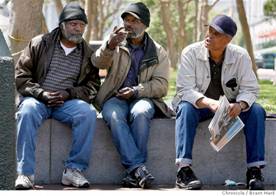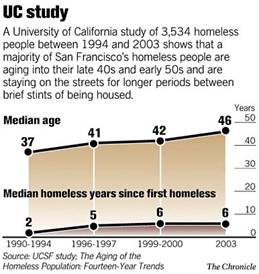|
S.F.'s Homeless Aging on the Street
By Kevin Fagan, San Francisco Chronicle
August
4, 2006

Clarence, 58, William, 53, and William, 61, (from left) hang out near the Civic Center farmers' market. Clarence is homeless; the other two have been homeless but are off the streets now. Chronicle photo by Brant Ward
Chronic health problems on the rise as median age nears 50
A majority of the homeless people on San Francisco's streets have been there since the 1980s and never left, and without concentrated care they soon will start crowding hospital emergency rooms and dying in large numbers, according to a 14-year-long, first-of-its-kind examination of chronic homelessness in the United States.
The finding -- which the researchers say is reflected in other cities -- is sure to give added impetus to initiatives in San Francisco and elsewhere to create more programs that combine permanent housing and social services for residents under the same roof.
Without such supportive housing programs, the aging homeless are likely to experience rapid health decline and death, said Judy Hahn, the UCSF assistant professor who led the study.
"The already-troubling health issues for these older street people are not going to go away. They will just get worse, and we will see them in increasing numbers in our hospitals," Hahn said. "If they don't go into the hospitals, many will simply die from living outside. Giving them a residence with on-site health care available will go a long way toward avoiding these troubles."
Thirty UC researchers and students surveyed homeless people in San Francisco during four periods -- 1990-1994, 1996-1997, 1999-2000 and 2003 -- and found the median age of the homeless rose from 37 years old at the start to 46 by the end. Today, they estimate, the median age of the city's homeless population is about 50 -- which in hard-time street years is the equivalent of about 65 given the physical wear and tear, they said.
As the median age grew, so did the number of years the homeless had been on the street, the survey found.
It also found worsening health problems usually associated with older people, reflected in higher rates of hypertension, diabetes and emphysema and in the number of emergency room visits. Hypertension, for instance, rose from 14 percent of those surveyed at the start of the 1990s to 21 percent in 2003.
The findings support what many social workers have long suspected -- that there was a "big bang" homeless population explosion as federal housing programs were slashed and the closing of mental hospitals hit home in the mid-1980s and that this core group constitutes the bulk of the street population.
Local and national homelessness experts said the study confirms their long-held belief that the homeless population is aging at an alarming rate and that the national movement to create supportive housing is going in the right direction.
"We've known instinctively about this phenomenon, but now having this research to back up that instinct is great," said Philip Mangano, President Bush's national point man on homelessness. "This shows that supportive housing is perfectly matched as an antidote to the premature aging of this population."
An account of the study's findings, co-written by Hahn and four other UC researchers, appeared this week in the Journal of General Internal Medicine.
Hahn said the "big bang" theory, first propounded in the early 2000s by University of Pennsylvania homelessness researcher Dennis Culhane, seems to be supported by her findings.
Aside from cuts to federal housing programs and the closing of mental institutions, she identified worsening drug abuse nationwide and rising housing prices as contributors to chronic homelessness over the past 20 years.
"It's clear to me, from our study, that a huge number hit the street back then, and some may have gone in and out of housing over the years, but they wind up back out there again," Hahn said. "The fact that the median age went up almost exactly with the calendar years as we did our study told us that this group wasn't being replenished by a lot of new people."
During the 14 years of research, 3,534 homeless adults were interviewed at six emergency shelters and soup kitchens. These included the biggest two such institutions in the city, Multi-Service Center South shelter, south of Market Street, and the St. Anthony Dining Room in the Tenderloin.
The team checked with social workers who worked closely with the homeless in Los Angeles, New York, St. Louis, Pittsburgh, Toronto and Philadelphia and reported that the same aging phenomenon appeared to be happening in those cities, too.
Trent Rhorer, director of city homeless policy and head of San Francisco's Human Services Agency, said the study "could have a huge policy implication."
"The study suggests that a one-time increase in the supportive housing stock could have a big impact on homelessness, and not only have we been doing that, but we intend to keep creating supportive housing in the future," Rhorer said.
"The report suggests exactly what we have assumed -- that we are dealing with what, to some extent, is a static population and that we are dealing with the largest portion of the problem right now."
In the past three years, the city has created 1,482 units of supportive housing for homeless people. San Francisco's 10-Year Plan to End Chronic Homelessness, written in 2004, calls for another 1,518 units to be created by 2010.
Michael Stoops, who has been working with the homeless around the country since the early 1980s and directs the National Coalition on Homelessness, said he isn't surprised by the report's findings because the U.S. population in general is aging as the Baby Boom generation grows.
"Boomers are the biggest segment of the population for decades, so just like in the rest of the population, Boomers are aging in the homeless population," Stoops said. "As they've aged, society has had a tendency to give up on them; the attitude is that they'll never get off the streets because they've been there too long."
The homeless population in San Francisco is estimated on any given night to be about 6,000, according to the last one-day homeless count conducted by the city, in 2005. Throughout an entire year, though, the number of people who experience homelessness at some point is estimated to be closer to 17,000.
"This is probably the most important thing I've seen written about San Francisco homelessness," said Dr. Josh Bamberger, who as housing and urban health director at the city Department of Public Health runs treatment programs for the most severely homeless people in the city. "It shows this is largely a static population that we can actually house and treat, and then we will see a reduction on the street.
"So much of the rhetoric we hear is that homeless people are moving into San Francisco all the time, and we can never stem the tide," said Bamberger, who helped in the early stages of the study. "But this absolutely refutes that."
Fifty-year-old Nathan "Nasty" Swift, who has the wrinkled face of a 65-year-old and has been homeless most of the time since 1981, said the study's findings "sound about right to me."
Swift was a submarine sonar technician in the Navy, but after he mustered out on July 5, 1980, he said, he did too many drugs and made too many bad job decisions to stay stable.
"I was like a lot of guys who just burned out and had nothing around to help us," he said, heading to a panhandling spot on Market Street near Van Ness Avenue. "That study says we're all old and our health is shot? Sounds like me and everyone I know.
"I don't see a lot of young guys out here anymore. Just old guys like me."


Copyright © Global Action on Aging
Terms of Use |
Privacy Policy | Contact
Us
|



